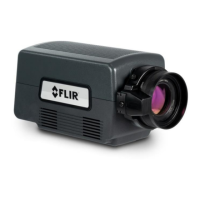5 –Camera Controller
A6000 and A8500 Series User’s Manual
19
5.2 Edit Filter Names (A678x and A858x only)
This dialog is accessed using the Edit Filter Names menu option under the “hamburger button”. This
allows the user to manually edit the names of the filters associated with each Filter ID. The user can
click “Reset to Default” to reset the Filter Name to the manufacturer default value.
5.3 Status Page
The Status Page gives general information about the camera state including camera model and serial
number, integration time, frame size, frame rate, camera time, FPA type, and internal temperatures.
The FPA temperature turns blue when the camera has reached its setpoint temperature, which is
nominally 77 K. The Time is in Julian Day format, with the number of days since the beginning of the
year, followed by the hour, minute, second and decimal second to 6 places. The Operating Time
display is in HH:MM elapsed since the camera was manufactured, or the timer was reset at the
factory.
The Type entry is the configuration of the integrated detector cooler assembly. In the example below,
the sensor readout IC type is the 1308 which is used in the A858X camera family. “8CH” means 8
digitizer channels. “InSb” is indium antimonide, the detector type. “f/2.5” is the f/number of the
coldshield. “3 to 5” is the wavelength range of the cold filter. “Front Panel” and “Air Gap” are the
temperatures of temperature sensors in the camera’s lens interface. These sensors are used for Tdrift
correction, a type of radiometric compensation for changes in the optics temperature that will affect
radiometric measurements. The factory calibrations are done in an air-conditioned laboratory with a
nominal temperature of 23 °C. If the camera is subsequently operated in a hot ambient environment,
the total radiance reaching the sensor will be higher than it would be if the camera was still at 23 °C.
This produces a radiance offset which leads to a temperature measurement error. The Tdrift
compensation uses the measurements of the two temperature sensors to correct for the radiance
offset in the digital image data.

